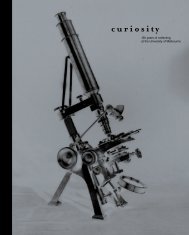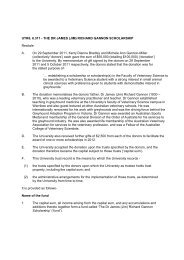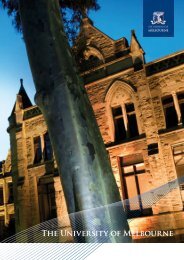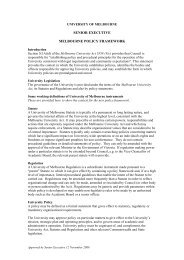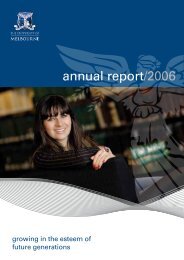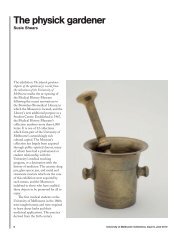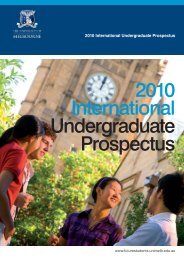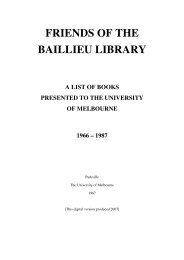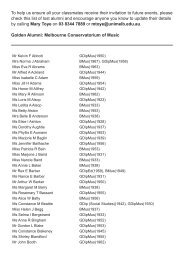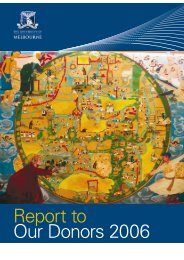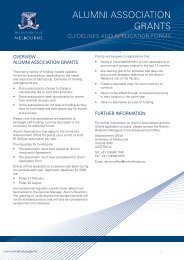Mr de B*** and his airs of mystery - University of Melbourne
Mr de B*** and his airs of mystery - University of Melbourne
Mr de B*** and his airs of mystery - University of Melbourne
Create successful ePaper yourself
Turn your PDF publications into a flip-book with our unique Google optimized e-Paper software.
<strong>Mr</strong> <strong>de</strong> <strong>B***</strong> <strong>and</strong> <strong>his</strong> <strong>airs</strong> <strong>of</strong> <strong>mystery</strong><br />
Richard Excell<br />
On Wednesday 2 August 2006 the<br />
Music Library at the <strong>University</strong> <strong>of</strong><br />
<strong>Melbourne</strong> was renamed the Louise<br />
Hanson-Dyer Music Library, in<br />
honour <strong>of</strong> the patron <strong>and</strong> publisher<br />
whose bequest <strong>of</strong> her own<br />
outst<strong>and</strong>ing private collection had<br />
finally arrived at the <strong>University</strong> a few<br />
months earlier. 1 Since the arrival <strong>of</strong><br />
the Hanson-Dyer Collection, several<br />
new acquisitions for the Rare<br />
Collections <strong>of</strong> that library have been<br />
specifically chosen to complement its<br />
strengths, such as music theory 2 <strong>and</strong><br />
especially 18th century French<br />
music. 3<br />
A recent catalogue from Lisa Cox<br />
Music, an English <strong>de</strong>aler in rare <strong>and</strong><br />
antiquarian music, listed an item<br />
which was clearly <strong>of</strong> interest to us,<br />
both because the Hanson-Dyer<br />
Collection contains several<br />
comparable 18th century anthologies<br />
<strong>of</strong> French songs, <strong>and</strong> because it had<br />
an element <strong>of</strong> <strong>mystery</strong>:<br />
44<br />
1. ANON<br />
Nouveau Recueil d’Airs Serieux<br />
et a Boire Composés Par <strong>Mr</strong> De<br />
B…. Livre Premiere. Paris, Le Sr.<br />
Boivin; Le Sr. Le Clair, 1731.<br />
First edition. 1f., 19pp., engraved<br />
oblong 4to. Later boards,<br />
stamped in gilt. A very nice copy.<br />
Unrecor<strong>de</strong>d: not in WorldCat,<br />
the British Library Integrated<br />
Catalogue, CPM, BUC, RISM<br />
or the Bibliothèque Nationale<br />
Catalogue.<br />
Alfred Cortot’s copy with <strong>his</strong><br />
book plate on front end-paper<br />
<strong>and</strong> with <strong>his</strong> autograph<br />
annotations i<strong>de</strong>ntifying the<br />
composer as René Drouard <strong>de</strong><br />
Bousset (1703–1760). Cortot’s<br />
i<strong>de</strong>ntification is questionable:<br />
Bousset did compose two books<br />
<strong>of</strong> Airs serieux et à boire <strong>and</strong> both<br />
were published in Paris 1731 by<br />
the author (one location only<br />
cited by RISM) but the titles<br />
differ consi<strong>de</strong>rably from ours. 4<br />
It was easy to share the <strong>de</strong>aler’s<br />
scepticism about Cortot’s<br />
i<strong>de</strong>ntification—the great pianist ma<strong>de</strong><br />
worse errors <strong>of</strong> judgement than t<strong>his</strong>—<br />
<strong>and</strong> the volume does in<strong>de</strong>ed appear to<br />
be unrecor<strong>de</strong>d elsewhere. 5 After<br />
extensive searching through the<br />
relevant musical dictionaries <strong>and</strong> biobibliographies,<br />
however, it was also<br />
easy to see why Cortot had suggested<br />
Bousset: there is simply no other<br />
French composer <strong>of</strong> the time with a<br />
name beginning with ‘B’ who fits the<br />
bill any better.<br />
We <strong>de</strong>ci<strong>de</strong>d to buy t<strong>his</strong> intriguing<br />
item, using funds from the Library<br />
Endowment Fund. When the slen<strong>de</strong>r<br />
but attractively engraved volume<br />
arrived in <strong>Melbourne</strong> the <strong>mystery</strong><br />
only <strong>de</strong>epened. While the vast corpus<br />
<strong>of</strong> ‘Airs sérieux’ (literally ‘Serious<br />
songs’, though they are <strong>of</strong>ten not at<br />
all serious in tone) <strong>and</strong> ‘Airs à boire’<br />
(Drinking songs) contains many<br />
mo<strong>de</strong>st trifles, the contents <strong>of</strong> t<strong>his</strong><br />
book were clearly the work <strong>of</strong> a<br />
sop<strong>his</strong>ticated composer, <strong>and</strong> the<br />
presence <strong>of</strong> an air celebrating the<br />
birth <strong>of</strong> the Dauphin even hinted at a<br />
connection with the royal court at<br />
Versailles.<br />
The remaining hope <strong>of</strong><br />
i<strong>de</strong>ntifying ‘<strong>Mr</strong>. <strong>de</strong> <strong>B***</strong>’ rested with<br />
tracing some <strong>of</strong> the 12 individual<br />
songs. T<strong>his</strong>, however, is not a simple<br />
matter.<br />
Even when we restrict ourselves<br />
to just those <strong>airs</strong> which appeared in<br />
collections published in Paris, we find<br />
that over 10,000 from the first half<br />
<strong>of</strong> the 18th century still survive.<br />
Worse still, many <strong>of</strong> these appeared<br />
anonymously or in incomplete forms,<br />
<strong>and</strong> where composers are given, we<br />
can never be sure that the <strong>airs</strong> are not<br />
parodies, plagiarisms or extracts from<br />
now lost operas. 6<br />
As it turned out, the key was to be<br />
found in one <strong>of</strong> the many further<br />
collections not published in Paris<br />
or even France. The most nearly<br />
contemporaneous collection to h<strong>and</strong><br />
was no. 166 <strong>of</strong> the Hanson-Dyer<br />
<strong>University</strong> <strong>of</strong> <strong>Melbourne</strong> Collections, Issue 2, July 2008
Collection, a set <strong>of</strong> seven volumes <strong>of</strong> a<br />
Nouveau recueil <strong>de</strong> chansons choisies<br />
(New collection <strong>of</strong> selected songs)<br />
published by J. Neaulme in The<br />
Hague from 1731 to 1736. Each<br />
volume contains about 100 songs,<br />
prece<strong>de</strong>d by indices according to<br />
genre <strong>and</strong>, mercifully, a ‘Table<br />
Alphabetique’. After a couple <strong>of</strong> false<br />
trails (songs with similar texts but<br />
unrelated music), the seventh volume<br />
yiel<strong>de</strong>d up a perfect concordance for<br />
the music <strong>of</strong> ‘Etre a table, Prés d’un<br />
objet aimable’ (To be at the table, near<br />
the object <strong>of</strong> one’s affections) un<strong>de</strong>r<br />
the very useful rubric: ‘Les plaisirs<br />
<strong>de</strong> la vie. Duo <strong>de</strong> <strong>Mr</strong>. <strong>de</strong> Blamont’<br />
(The pleasures <strong>of</strong> life. Duo by <strong>Mr</strong> <strong>de</strong><br />
Blamont). 7<br />
Not only was the composer’s<br />
i<strong>de</strong>ntity finally revealed, it also<br />
became apparent why it had been so<br />
elusive. ‘<strong>Mr</strong> <strong>de</strong> Blamont’ does in<strong>de</strong>ed<br />
appear in music dictionaries, but<br />
un<strong>de</strong>r ‘C’ rather than ‘B’. His father<br />
was Nicolas Colin, ordinaire <strong>de</strong> la<br />
musique du roi (the title for a regular<br />
member <strong>of</strong> the royal music<br />
establishment), but with a strong<br />
interest also in painting. Our<br />
composer (born 22 November 1690,<br />
died 14 February 1760) was known as<br />
François Colin [or Collin] <strong>de</strong><br />
Blamont, 8 while <strong>his</strong> younger brother,<br />
a painter, was Hyacinthe Colin <strong>de</strong><br />
Vermont. 9 The young Colin <strong>de</strong><br />
Blamont’s musical ability impressed<br />
Michel-Richard <strong>de</strong> Lalan<strong>de</strong>, whose<br />
pupil he became. In 1719 he attained<br />
the post <strong>of</strong> Surintendant <strong>de</strong> la musique<br />
<strong>de</strong> la chambre <strong>and</strong> other court<br />
positions followed, with duties <strong>and</strong><br />
rights which he <strong>de</strong>fen<strong>de</strong>d fiercely. 10<br />
His greatest success, the ballethéroïque:<br />
Les fêtes grecques et romaines<br />
<strong>of</strong> 1723, 11 is also represented in<br />
Neaulme’s Nouveau recueil, in the<br />
form <strong>of</strong> a ‘Parodie, tirée <strong>de</strong>s Fêtes<br />
Grecques & Romaines. De <strong>Mr</strong>. <strong>de</strong><br />
Blamont’ on page 39 <strong>and</strong> another<br />
similar ‘parody’ (i.e. new words to an<br />
existing tune) on page 41.<br />
Once the composer had been<br />
i<strong>de</strong>ntified it became clear that two<br />
more songs from our Novueau recueil<br />
<strong>of</strong> 1731, the Air tendre: ‘Heureux<br />
oyseaux, vous chantez’ (Happy birds,<br />
[François Colin <strong>de</strong> Blamont], Novueau recueil<br />
d’<strong>airs</strong> serieux et a boire composés par <strong>Mr</strong>. <strong>de</strong> <strong>B***</strong> livre<br />
premier, Paris: Boivin; Le Clair, 1731. Louise<br />
Hanson-Dyer Music Library Rare Collections,<br />
acquired October 2007.<br />
Left: title page; right: p. 13.<br />
you sing) <strong>and</strong> the Vau<strong>de</strong>ville: ‘La triste<br />
philosophie’ (Sad philosophy), had<br />
previously appeared un<strong>de</strong>r <strong>his</strong> name<br />
in the journal Mercure <strong>de</strong> France in<br />
1728. 12 In addition ‘Etre a table’ also<br />
appears anonymously in several<br />
manuscript collections now in the<br />
United States <strong>and</strong> Swe<strong>de</strong>n. 13 One <strong>of</strong><br />
these Swedish manuscripts has<br />
versions <strong>of</strong> three more <strong>of</strong> the simpler<br />
songs from the Novueau recueil, but<br />
for voice alone without the<br />
accompanying figured bass part. 14<br />
The very inconsistent nomenclature<br />
for sub-genres <strong>of</strong> the French air is<br />
also in evi<strong>de</strong>nce: ‘Air tendre’ for ‘Air<br />
léger’ <strong>and</strong> ‘Brunette’ for ‘Vau<strong>de</strong>ville’.<br />
These traits are all consistent with a<br />
wi<strong>de</strong> but haphazard circulation <strong>of</strong> the<br />
less challenging varieties <strong>of</strong> air among<br />
enthusiastic amateurs.<br />
<strong>University</strong> <strong>of</strong> <strong>Melbourne</strong> Collections, Issue 2, July 2008 45
[Colin <strong>de</strong> Blamont], Novueau recueil, p. 7.<br />
There are other songs in the<br />
Novueau recueil, however, which are<br />
far more vocally <strong>de</strong>m<strong>and</strong>ing, <strong>and</strong> were<br />
probably performed initially at court<br />
or at the Concert Français 15 by leading<br />
French singers <strong>of</strong> the day, perhaps the<br />
sopranos Mes<strong>de</strong>moiselles Antier, Le<br />
Maure <strong>and</strong> Pélissier, <strong>and</strong> the bass<br />
Thévenard. The unaccompanied bass<br />
Air à boire: ‘Les beaux jours <strong>de</strong><br />
Printemps’ (Drinking song: The fine<br />
days <strong>of</strong> Spring), for example, seems<br />
perfectly fitted to Thévenard’s<br />
‘sonorous, supple <strong>and</strong> wi<strong>de</strong>-ranging’<br />
voice. 16<br />
I<strong>de</strong>ntifying the composer also has<br />
a bearing on the performance <strong>of</strong> these<br />
songs. Like most French Baroque<br />
music, the songs <strong>of</strong> the Novueau<br />
recueil are liberally supplied with<br />
indications <strong>of</strong> ca<strong>de</strong>ntial trills, but here<br />
there are three distinct symbols. Two<br />
<strong>of</strong> them, a wavy line <strong>and</strong> a cross, were<br />
wi<strong>de</strong>ly (if not consistently) used, but<br />
the third, a cross with two additional<br />
oblique strokes, is quite unusual. It<br />
does appear, however, in the last <strong>of</strong><br />
Colin <strong>de</strong> Blamont’s volumes <strong>of</strong><br />
French cantatas, 17 along with a<br />
prefatory note by the composer<br />
explaining the distinct meanings <strong>of</strong><br />
all three symbols: ‘feinte’, ‘jettée’ <strong>and</strong><br />
‘appuyée’ respectively. 18<br />
The birth <strong>of</strong> an heir in the direct<br />
royal line on 4 September 1729<br />
occasioned great rejoicing <strong>and</strong> public<br />
46<br />
celebration. Many theatrical, literary<br />
<strong>and</strong> musical works were created, 19 <strong>and</strong><br />
Colin <strong>de</strong> Blamont was heavily<br />
involved from the start. Within a<br />
month he <strong>and</strong> one <strong>of</strong> <strong>his</strong> librettists,<br />
the Abbé Pellegrin, had compiled a<br />
gr<strong>and</strong> ballet, Le Parnasse, from various<br />
works by Lully, Campra, Destouches,<br />
Mouret <strong>and</strong> Colin himself. His own<br />
contributions to that compilation<br />
inclu<strong>de</strong>d excerpts from Les fêtes<br />
grecques et romaines, the divertissement:<br />
Le retour <strong>de</strong>s dieux sur la terre (The<br />
return <strong>of</strong> the gods to earth) written<br />
for the wedding <strong>of</strong> Louis XV <strong>and</strong><br />
Maria Leszczynska ´<br />
in 1725, <strong>and</strong> the<br />
Idylle: Les présents <strong>de</strong>s dieux (Idyll:<br />
The gifts <strong>of</strong> the gods) created in 1727<br />
to celebrate the birth <strong>of</strong> the couple’s<br />
twin daughters. The anniversary<br />
celebrations <strong>of</strong> September 1730 saw<br />
a new divertissement by Colin,<br />
Le Caprice d’Erato, ou Les caractères<br />
<strong>de</strong> la musique.<br />
The music <strong>of</strong> Les présents <strong>de</strong>s dieux<br />
has not survived, but it appears that<br />
the ‘Air sur la Naissance <strong>de</strong> Mgr. Le<br />
Dauphin’ in our Novueau recueil<br />
preserves one <strong>of</strong> the numbers recycled<br />
by Colin in Le Parnasse. The flowery<br />
<strong>University</strong> <strong>of</strong> <strong>Melbourne</strong> Collections, Issue 2, July 2008
text certainly celebrates a royal birth,<br />
but it is not specific about number or<br />
gen<strong>de</strong>r, <strong>and</strong> could serve equally well<br />
for the twin girls <strong>and</strong> for the longawaited<br />
male heir:<br />
Enfin le doux Printemps reparroit a<br />
nos yeux,<br />
Bientôt nous allons voir enrichir la<br />
nature<br />
De fruits <strong>de</strong> fleurs et <strong>de</strong> verdure,<br />
Flore et Zephyr reviennent en ces<br />
lieux,<br />
Chantez petits oiseaux, redoublés<br />
vos ramages,<br />
Apprenez aux Echos <strong>de</strong> ces riants<br />
boccages,<br />
Le bonheur qui nous est promis,<br />
Chantez sous ces naissants<br />
feuillages,<br />
L’honneur et la gloire <strong>de</strong>s Lys.<br />
(At last sweet Spring reappears<br />
before our eyes; soon we are<br />
going to see nature enriched with<br />
fruits, flowers <strong>and</strong> greenery. Flora<br />
<strong>and</strong> Zephyr return to these l<strong>and</strong>s.<br />
Sing, little birds, redouble your<br />
flourishes, hearken to the echoes<br />
from these cheerful woods, the<br />
Nouveau recueil <strong>de</strong> chansons choisies,<br />
tome septieme, The Hague: J. Neaulme, 1736.<br />
Louise Hanson-Dyer Music Library,<br />
Hanson-Dyer Collection no. 166, vol. 7.<br />
Left: title page; right: p. 53.<br />
happiness which is promised us.<br />
Sing, upon t<strong>his</strong> budding foliage,<br />
the honour <strong>and</strong> the glory <strong>of</strong> the<br />
Lily [i.e. the royal Fleur-<strong>de</strong>-<br />
Lys].)<br />
Why t<strong>his</strong> one song should have been<br />
published separately two years later<br />
remains a puzzle, however. In t<strong>his</strong><br />
matter the Dictionnaire <strong>de</strong>s théatres <strong>de</strong><br />
Paris by the theatre-loving Parfaict<br />
brothers provi<strong>de</strong>s some suggestive<br />
information. Its account <strong>of</strong> Le<br />
Parnasse 20 reveals that in the relevant<br />
section, ‘La Muse Pastorale, III.<br />
Entrée’, the singers were:<br />
Un Berger (a shepherd)<br />
Le Sieur Dangerville.<br />
Deux Bergéres (two shepher<strong>de</strong>sses)<br />
Mlles Antier & Le Maure.<br />
Une autre Bergére<br />
(another shepher<strong>de</strong>ss)<br />
Mlle Pélissier.<br />
Since our ‘Air sur la Naissance’ is for a<br />
single soprano, it is only the ‘other<br />
shepher<strong>de</strong>ss’, Mlle Pélissier (who<br />
appears in just t<strong>his</strong> scene), who could<br />
have been the singer. But at the end<br />
<strong>of</strong> its article on ‘Le Parnasse’, Parfaict’s<br />
Dictionnaire tells us that due to<br />
‘indisposition’ Mlle Pélissier was<br />
unable to take her role in the first<br />
<strong>University</strong> <strong>of</strong> <strong>Melbourne</strong> Collections, Issue 2, July 2008 47
[Colin <strong>de</strong> Blamont], Novueau recueil, insi<strong>de</strong> front<br />
cover with Alfred Cortot’s bookplate <strong>and</strong> <strong>his</strong><br />
pencilled classification <strong>and</strong> shelfmark above<br />
(‘MVP’ = ‘Musique vocale pr<strong>of</strong>ane’; cf. Albi<br />
Rosenthal, ‘Alfred Cortot as collector <strong>of</strong> music’ in<br />
Oliver Neighbour (ed.), Music <strong>and</strong> bibliography:<br />
Essays in honour <strong>of</strong> Alec Hyatt King, London:<br />
Bingley, 1980, pp. 206–214) <strong>and</strong> <strong>his</strong> erroneous<br />
attribution below.<br />
performance before the king in the<br />
Cour <strong>de</strong> Marbre at Versailles, playing it<br />
only later in Paris at the Théatre <strong>de</strong><br />
l’Aca<strong>de</strong>mie Royale <strong>de</strong> Musique. 21 Finally<br />
there is a reason for the orphan-like<br />
position <strong>of</strong> t<strong>his</strong> particular song: even a<br />
piece <strong>of</strong> music suffered a loss <strong>of</strong> status<br />
if it had not been formally presented<br />
to royalty. Paradoxically, it may owe<br />
its tenuous survival in the Novueau<br />
recueil to the fact that it was not heard<br />
at Versailles on 5 October 1729.<br />
In other publications François<br />
Colin <strong>de</strong> Blamont proudly para<strong>de</strong>s <strong>his</strong><br />
royal patronage, <strong>his</strong> full name <strong>and</strong> <strong>his</strong><br />
place in the musical hierarchy. But<br />
when in t<strong>his</strong> slim volume he did flirt<br />
with obscurity as ‘<strong>Mr</strong>. <strong>de</strong> <strong>B***</strong>’ he was<br />
almost too self-effacing.<br />
[POSTSCRIPT: Since t<strong>his</strong> article was written<br />
there have been new <strong>de</strong>velopments with regard to<br />
t<strong>his</strong> volume. The Centre <strong>de</strong> Musique Baroque <strong>de</strong><br />
Versailles has recently published an online<br />
catalogue <strong>of</strong> the works <strong>of</strong> Colin <strong>de</strong> Blamont,<br />
prepared by Benoît Dratwicki. 22 A lost ‘Recueil<br />
d’<strong>airs</strong>, I’ is noted, with what information<br />
Dr Dratwicki had been able to <strong>de</strong>duce about it<br />
from other sources. He was naturally very pleased<br />
to learn that t<strong>his</strong> volume is not lost after all—<br />
calling it ‘excellent news’ <strong>and</strong> a ‘great<br />
discovery’—<strong>and</strong> a digital copy has been or<strong>de</strong>red<br />
<strong>and</strong> prepared for the CMBV.]<br />
48<br />
Richard Excell is a musicologist <strong>and</strong> librarian<br />
who currently holds the position <strong>of</strong> Rare Music<br />
Cataloguer at the <strong>University</strong> <strong>of</strong> <strong>Melbourne</strong>. He<br />
has a Bachelor <strong>of</strong> Arts (Honours) <strong>de</strong>gree in music<br />
<strong>and</strong> a Master <strong>of</strong> Arts (Librarianship) from<br />
Monash <strong>University</strong>, <strong>and</strong> is a member <strong>of</strong> the<br />
medieval music ensemble Acord.<br />
Notes<br />
1 Denis Herlin, Catalogue <strong>de</strong> la Collection<br />
musicale Hanson-Dyer, Université <strong>de</strong> <strong>Melbourne</strong>,<br />
Parkville: <strong>University</strong> <strong>of</strong> <strong>Melbourne</strong>, 2006;<br />
Richard Excell <strong>and</strong> Jennifer Hill, Bowerbird<br />
to lyrebird: The Louise Hanson-Dyer Music<br />
Collection. A Baillieu Library exhibition,<br />
3 August to 24 September 2006, Parkville:<br />
<strong>University</strong> <strong>of</strong> <strong>Melbourne</strong>, 2006.<br />
2 Including works by Giovenale Sacchi <strong>and</strong><br />
Pietro Pontio.<br />
3 Including printed <strong>and</strong> manuscript material by<br />
Marin Marais, François André Danican<br />
Philidor <strong>and</strong> Jean Clau<strong>de</strong> Trial, Jean-Benjamin<br />
<strong>de</strong> Labor<strong>de</strong>, François Francoeur <strong>and</strong> François<br />
Rebel, Christoph Willibald von Gluck, Pierre-<br />
Alex<strong>and</strong>re <strong>de</strong> Monsigny <strong>and</strong> André Ernest<br />
Mo<strong>de</strong>ste Grétry.<br />
4 Lisa Cox Music: Catalogue 56, Exeter: Lisa Cox,<br />
2007.<br />
5 Whether one spells the first word ‘Nouveau’ or,<br />
as it is printed on the original, ‘Novueau’. The<br />
latter spelling is used in t<strong>his</strong> article as it avoids<br />
ambiguity. The non-st<strong>and</strong>ard spellings used<br />
elsewhere in the publications un<strong>de</strong>r discussion<br />
have been transcribed unaltered.<br />
6 Tony Eastwood, ‘The French air in the<br />
eighteenth century: A neglected area’, Studies<br />
in Music (W.A.), no. 18, 1984, p. 85.<br />
7 Nouveau recueil <strong>de</strong> chansons choisies, Tome<br />
septieme, The Hague: J. Neaulme, 1736, pp.<br />
53–59. At the end <strong>of</strong> t<strong>his</strong> song: ‘Les Paroles sont<br />
<strong>de</strong> <strong>Mr</strong>. Tanevot.’ (The words are by <strong>Mr</strong><br />
Tanevot).<br />
8 James R. Anthony, ‘Collin [Colin] <strong>de</strong> Blamont,<br />
François’ in Grove music online, accessed<br />
5 February 2008.<br />
9 His godfather was the leading portrait painter<br />
at the court <strong>of</strong> Louis XIV, Hyacinthe Rigaud.<br />
10 John E. Morby, ‘The great chapel-chamber<br />
controversy’, Musical Quarterly, vol. 58, no. 3,<br />
July 1972, pp. 383–397.<br />
11 Revived many times, the last as late as 1770.<br />
12 Répertoire international <strong>de</strong>s sources musicales<br />
[hereafter RISM], Kassel: Bärenreiter, 1971–,<br />
A/I: C 3333 (as ‘Heureux oiseau, vous chantés’)<br />
<strong>and</strong> CC 3333a (as a ‘Duo’) respectively.<br />
13 RISM A/II: 101.712 [transposed for 2 basses];<br />
117.185; 190.001.508 <strong>and</strong> 190.013.777.<br />
14 RISM A/II: 190.014.570; 190.014.619 <strong>and</strong><br />
190.014.751.<br />
15 David Tunley, ‘Philidor’s Concerts Français’,<br />
Music <strong>and</strong> Letters, vol. 47, no. 2, April 1966, pp.<br />
130–134.<br />
16 Evrard Titon du Tillet, Le Parnasse françois,<br />
Paris: Coignard fils, 1732; suppl. 1743, p. 797<br />
(‘sa voix étoit sonore, moileuse & étendue’).<br />
17 François Colin <strong>de</strong> Blamont, Cantates françoises<br />
… Livre troisième, Paris: Boivin; Le Clair,<br />
1729.<br />
18 A brief trill at the beginning <strong>of</strong> the note, a<br />
sustained trill for the full note, <strong>and</strong> a trill<br />
which dwells on the initial upper note.<br />
19 An account <strong>and</strong> anthology was published in<br />
1731: Histoire <strong>de</strong> l’auguste naissance <strong>de</strong><br />
Monseigneur le Dauphin, divisée en trois parties<br />
... par le chevalier Dau<strong>de</strong>t, Paris: Le Mercier fils,<br />
1731.<br />
20 François Parfaict <strong>and</strong> Clau<strong>de</strong> Parfaict,<br />
Dictionnaire <strong>de</strong>s théatres <strong>de</strong> Paris, Paris: Rozet,<br />
1767, tome iv, pp. 76–78 (online at http://<br />
cesar.org.uk/cesar2/books/parfaict_1767,<br />
accessed 22 January 2008).<br />
21 Whether Pélissier’s indisposition was related<br />
to her rivalry with Le Maure is unclear. Their<br />
respective merits were championed by<br />
partisans known as mauriens <strong>and</strong> pélissiens.<br />
Titon du Tillet, Parnasse, quotes a line by<br />
Voltaire: ‘Pélissier par son art, le Maure par sa<br />
voix.’<br />
22 http://philidor.cmbv.fr/catalogue/<br />
intro-blamont, accessed 7 May 2008.<br />
<strong>University</strong> <strong>of</strong> <strong>Melbourne</strong> Collections, Issue 2, July 2008



